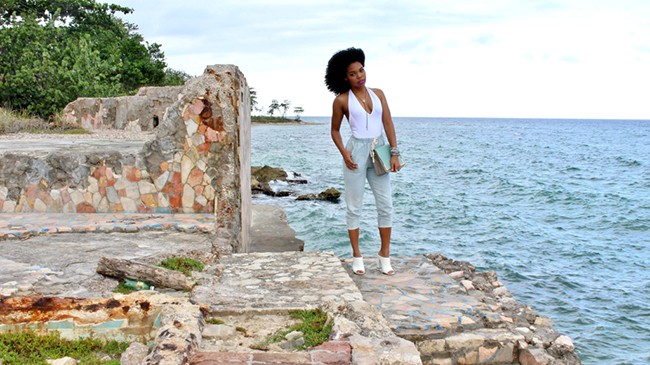
Polymer scientists continually collaborate with cosmetic chemists and formulators to develop new molecules designed to overcome limitations that exist with currently available ingredients. One example of such work is Polyquaternium-59 (Crodasorb UV-HPP”>, a cationic polymer which is now being used in a number of commercially-available skin and hair care formulations, including some products by Ouidad. Since the structure, function, and performance of the polymers in this category can vary so widely, as each is specifically tailored to meet a targeted need, it is worthwhile to take the time to examine this particular polymer to gain an understanding of its potential benefits to both the consumer and the chemist in a formulation.
What is it?
Polyquaternium-59 is a polyester molecule that has quaternized ammonium sites (positively-charged”> along both its backbone as well as in pendant groups attached to the chain.
(IUPAC name: Poly(20,25-dioxo-2,5,10,15,18-pentamethyl-10-(2-hydroxy-3-(3-(3-phenyl-2-propenamido”>propyldimethylammonio”>propyl”>-10-azonia-1,4,7,13,16,19-hexaoxapentacosanediyl”> chloride”>
Compared to many cationic polymers, it is of relatively low molecular weight, averaging 5000 grams per mole, and according to the manufacturer, Croda, it is 65% active, which means it has a high level of charge density relative to other polyquaternium materials used in cosmetic applications. This enhances the water solubility of these polymers and also increases substantivity to hair, and thus improves conditioning properties. The high degree of water solubility also means this polymer is suitable for cold mix processes, which is appealing to formulators from both a cost-saving perspective and from an environmentally friendly manufacturing paradigm. [i]
The novel twist to the polymer structure in PQ-59 is the inclusion of groups capable of absorbing UV radiation at the ends of the pendant groups. (For those interested in the specific organic chemistry, these groups are a carbonyl group conjugated diene/ aromatic moieties “>. These portions of the molecule transform the harmful, high energy UV radiation into a lower energy form (infrared”> that is emitted as heat. This sun protection quality is perhaps the most valuable contribution this polymer makes to any personal care product formula.
Sun Protection for Hair
The surface of human hair is highly hydrophobic, which helps to seal moisture into the hair shaft, protect it from the environment and mitigate effects from fluctuations in humidity that can cause structural damage.
Exposure to ultraviolet radiation occurs whenever we go outside. We are all well aware of the importance of limiting skin exposure to these harmful rays, but it is less well known the extent of damage they do to hair as well. UV-B radiation (280-320 nm”> cleaves disulfide bonds (S-S”> in the cuticle, depletes cystine in the structure, and thus damages the protein structure of the protective cover of the hair strand. This increases surface roughness and porosity, which results in frizz, tangling, and ultimately, breakage. Breakage of disulfide bonds can also lead to frizz and unmanageability as it disrupts curl structures. [ii]
UV also depletes the protective lipids found on the surface of the cuticle. This increases combing forces necessary to detangle hair, which generally results in formation of split ends and breakage.
The surface of human hair is highly hydrophobic, which helps to seal moisture into the hair shaft, protect it from the environment and mitigate effects from fluctuations in humidity that can cause structural damage. UV-B breaks down tryptophan found in the protein structure of the hair and creates a more highly negatively charged surface, which becomes more hydrophilic and less capable of moisture retention and more susceptible to ill effects from the environment.
Ultraviolet radiation also penetrates into the cortex of the hair where it breaks down protein structures within the hair strand as well, compromising the mechanical integrity of the hair. This results in a lower tensile strength for the hair, and so it breaks more easily. UV-A radiation in the cortex reacts with both natural melanin pigments and chemical dye molecules, causing photobleaching and yellowing, both definitely undesirable effects.
Clearly, protecting hair from damage from ultraviolet radiation is a desirable goal, for health, strength, luster, color retention and overall beauty of our tresses. This is especially true for longer hair, as damage is cumulative. Since wearing a hat everywhere does not seem like a fashionable solution, chemists and formulators have been experimenting with different ingredients for a while. Some of the limitations of common sun protective ingredients in current use are that the smaller molecules are not very substantive to hair, and they are often very greasy. For this reason, polyquaternium-59 was developed to overcome some of the deficiencies of other options. Its greater charge density as a cationic polymer enhances its substantivity to the surface of hair, which carries a slight negative charge. Also, as a lighter weight, water-soluble polymer, it has no greasy tactile sensation.
Read More: The Best Vitamin for Hair Growth?
Measuring Performance
PQ-59 has been found to mitigate damage caused by ultraviolet radiation and produces excellent results by preserving hair’s natural hydrophobicity, maintaining fiber tensile strength, and reducing combing forces. The synergistic combination of both substantive conditioning polymeric properties and UV-absorbing properties has the potential to create a uniquely effective molecule.
Many ingredients and products carry bold claims, but it can be difficult to determine true efficacy of the material. Fortunately the manufacturers of this polymer have done a large amount of scientific testing to evaluate the performance of PQ-59. It is important to keep in mind that with a vested economic interest in the success of the polymer, they are not unbiased, and thus the procedures, data and conclusions should be examined closely and with some degree of skepticism.
A variety of quantitative testing techniques were used to determine the ability of PQ-59 to provide protection from harmful UV radiation. Hair was treated with a 2% polymer solution in SLES (sodium lauryl ether sulfate”> and run against untreated hair and hair treated with small molecule uv-absorbers. All hair was tested before and after a dose of exposure to UV radiation equivalent to eighteen days.
The claims were substantiated by the following results. Dynamic contact angle experiments showed a (statistically significant”> higher degree of retained hydrophibicity on the surface of the hair compared to hair treated with a small molecule. Measurement of tryptophan levels at the surface via fluorescence spectroscopy revealed higher levels of retained tryptophan in treated hair versus untreated hair. Mechanical testing showed a five percent increase in tensile strength for irradiated hairs that had been treated with PQ-59 compared to untreated hairs. Scanning electron microscopy imaging of the cuticle showed a smoother, more intact surface for hairs treated with the polymer. Finally, spectrocolorimetric evaluation demonstrated increased color retention in fibers treated with the polymer. Third party visual inspection and comparison of treated versus untreated tresses also concluded that PQ-59 improved color retention after prolonged UV exposure.
The data certainly seem to support that this polymer can effectively mitigate damage caused to hair by exposure to ultraviolet radiation. It also does not appear to be necessary to use large quantities of the polymer, as 2% seems to provide significant benefit, even in a rinse-off product. It would be beneficial to see data run by an objective third party, but oftentimes, finished goods manufacturers do not make their data available to the public.
Notes for Curly Hair or No-Shampooers
Curly hair is especially susceptible to anything that could cause damage to the protein structure of the hair. For this reason, protecting it from environmental damage is essential, which includes limiting ultraviolet radiation exposure. PQ-59 seems to be an ingredient that can be quite useful for this purpose and is currently being incorporated into products with increasing frequency.
Polyquaternium-59 is extremely soluble in water, alcohol and glycerin. It is also very soluble in surfactant-containing mixtures, such as SLES, SLS, ALS and presumably cocamidopropyl betaine (although no specific data were found regarding the betaine”>. It also has a relatively small molecular size relative to other polymers used in hair care applications. So, while the positively charged polymer is substantive to the surface of the hair via electrostatic interactions with the negative charges on the cuticle, it seems probable that removal should be fairly simple via several different mechanisms, depending upon the preference of the user. No specific experiments studying the potential for buildup of these polymers on hair was found though, so as always, try it yourself, and see if you like it.
Want More?
10 Sun Protection Terms You Need to Know
Handling Diluted and Homemade Products
Follow Natasha Lee here:
Instagram and Stylish Lee
Sources
[i] Crodasorb UV-HPP, Technical Literature
[ii] Cardinali, S. Protecting Hair from UV Damage, Croda, Inc.
This article was originally published in September 2012 and has been updated for grammar and clarity.

